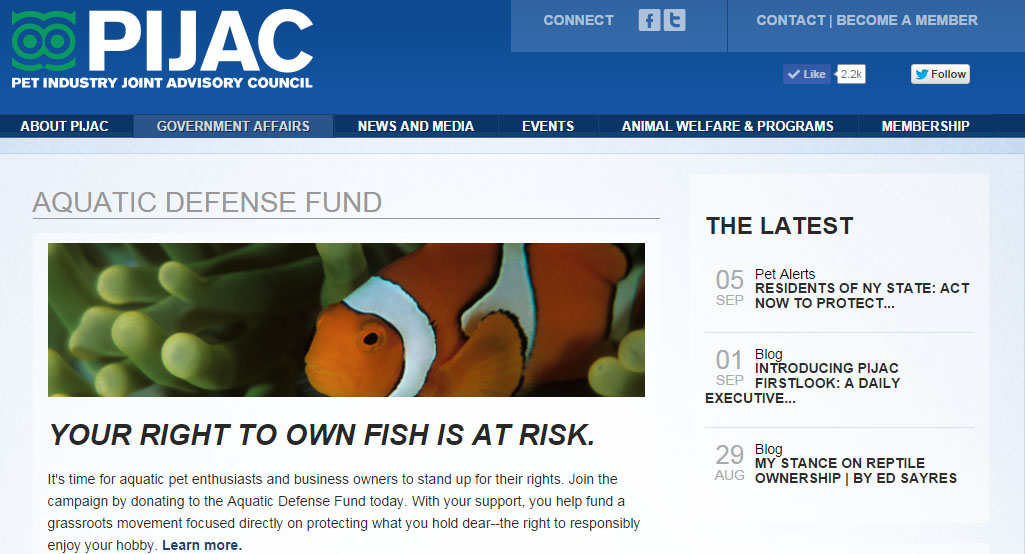Letter to MASNA – This is a republication of a PDF-formatted email received by CORAL Magazine editors on Sept 9th, 2014. You can download the original document here.
PET INDUSTRY JOINT
ADVISORY COUNCIL
1146 19th Street, N.W., Ste 350
Washington, DC 20036
Tel: 202-452-1525
Fax: 202-452-1516
MEMORANDUM
To: MASNA
From: Aquatics Committee
Sandy Moore, Co-Chair
Chris Buerner, Co-Chair
Julian Sprung
Dustin Dorton
Kevin Kohen
Laura Reid
Date: September 8, 2014
Do you love corals?
Following a 2009 petition from the Center for Biological Diversity (CBD) to list 83 reef-building coral species for protection under the U.S. Endangered Species Act (ESA), on August 28, 2014, the National Marine Fisheries Service (NMFS) listed 20 species of corals as threatened species. The final listing includes 5 coral species from the Caribbean, and 15 Indo-Pacific coral species from the genera Acropora, Euphyllia, Montipora, Pavona, Porites, and Seriatopora.
NMFS had originally proposed to list 66 reef-building species as threatened and endangered in December, 2012. However, based upon substantial scientific information submitted by the Pet Industry Joint Advisory Council (PIJAC) and other parties, NMFS determined only 20 of these species warranted listing as threatened species. Such scientific information included the submission of a scientific report developed by Dr. Charlie Veron, a world-renowned coral expert. PIJAC participated in the development of Dr. Veron’s work, and provided financial support enabling completion of this work.
In its final listing determination, NMFS elected not to apply the general ESA Section 9 “take” prohibitions to the newly-listed species. The term “take” is broadly defined to include a range of actions, including harassing, harming, injuring or killing a listed species. Instead, NMFS solicited comments regarding the appropriate scope of ESA Section 9 regulations, and indicated that it will consult with federal agencies and other partners to develop appropriate recovery strategies for the species.
PIJAC believes it likely that NMFS will apply the ESA Section 9 “take” prohibitions to the newly-listed coral species in the near future, consistent with prior agency actions. Application of these take prohibitions by NMFS could severely restrict or eliminate trade in these species. Such prohibitions may apply to both corals in the wild, as well as farm-raised corals. Such actions would be devastating to the marine aquarium hobby. Aquarium conferences, retail stores, wholesale suppliers, and coral farms would see an immediate direct impact, while manufacturers, dry goods suppliers, and mail order pet suppliers would experience the resulting loss of business too.
While we await further regulatory actions, anti-aquarium organizations will surely strive to create a social stigma for the aquarium industry by claiming, for example, that we are “trafficking in threatened and endangered species.” The emotion surrounding the subject will likely inflame public opinion and could motivate NMFS and the U.S. Fish and Wildlife Service to enact stricter importation rules on all corals.
NMFS’ action to list these species was driven by a petition filed by CBD. CBD indicated in its petition that climate change presents a significant risk for these species, requiring listing of these species under the ESA. CBD, effectively, is attempting to use the ESA as a tool to regulate greenhouse gas emissions. NMFS, likewise, relied on the effects of climate change to justify listing these 20 species. However, scientific information developed by world-renowned scientists indicate that none of the 20 listed coral species warrant listing under the ESA. These experts have stated in recent comments that NMFS’ final rule is not supported by the best available scientific information.
The Solution
PIJAC acted quickly to provide the best available scientific information to NMFS in response to CBD’s petition to list corals. PIJAC’s efforts are largely responsible for the dramatic reduction in the number of species listed, and the fact that none of these species were listed as endangered. But that is not enough. PIJAC must continue to work with the scientific community to develop and submit scientific information regarding marine species. PIJAC must also remain engaged in the legal and policy issues arising now that these 20 coral species have been listed by NMFS under the ESA.
This is a time consuming and expensive process, and it requires your support. All funds donated to PIJAC’s Aquatic Defense Fund will be directed toward either this specific process, or other existing antiaquarium campaigns.
Many eminent coral reef scientists are dismayed by the listing. ESA take prohibitions may be at odds with the best plan for the recovery of any coral species that might ever need a recovery plan– coral farming and restoration. ESA prohibitions may dramatically limit or eliminate conservation and education programs.
Please support PIJAC’s effort to defend our hobby against this and other actions including ones that aim directly to shut down our hobby. You can do so by making a donation, small or large, here:
www.pijac.org/marine.
Inspire your friends, your pet store, your aquarium club to do the same.
If you have any questions for PIJAC, contact marshall@pijac.org.






excellent publish, very informative. I wonder why the other
specialists of this sector don’t notice this. You must proceed your writing.
I am sure, you’ve a great readers’ base already!